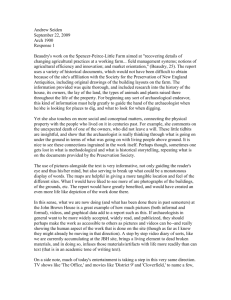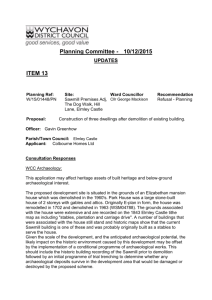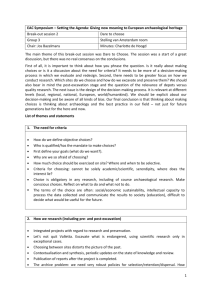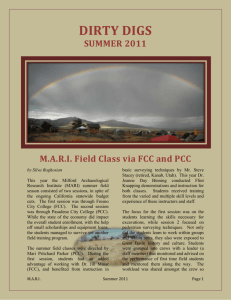Project Paper - Society for American Archaeology
advertisement
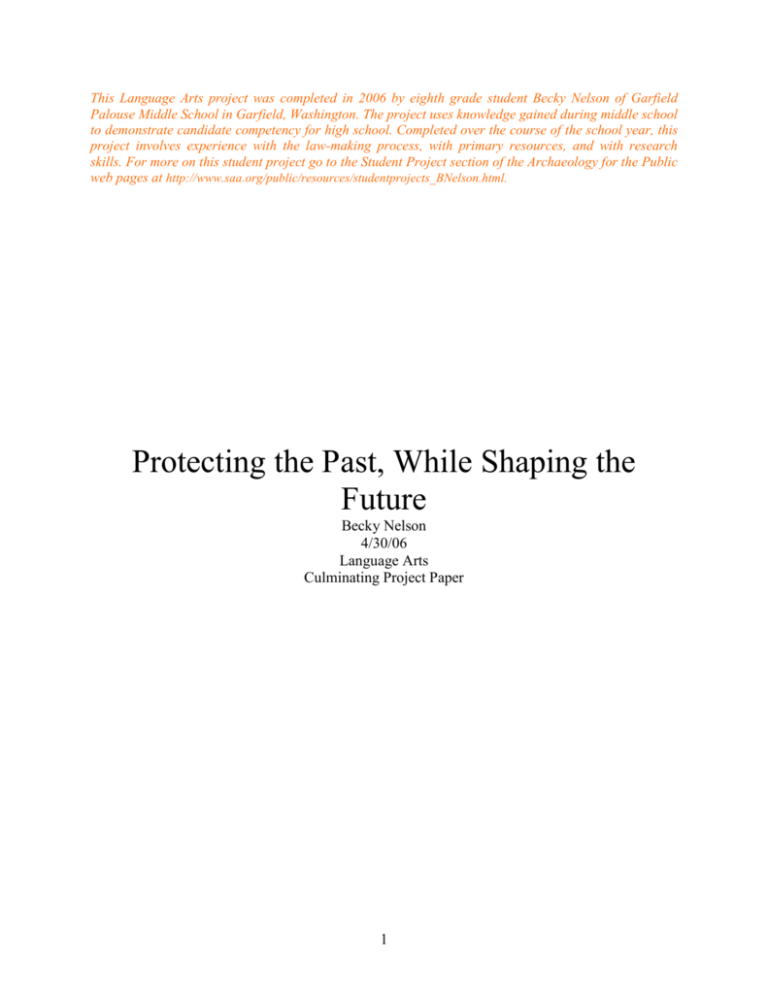
This Language Arts project was completed in 2006 by eighth grade student Becky Nelson of Garfield Palouse Middle School in Garfield, Washington. The project uses knowledge gained during middle school to demonstrate candidate competency for high school. Completed over the course of the school year, this project involves experience with the law-making process, with primary resources, and with research skills. For more on this student project go to the Student Project section of the Archaeology for the Public web pages at http://www.saa.org/public/resources/studentprojects_BNelson.html. Protecting the Past, While Shaping the Future Becky Nelson 4/30/06 Language Arts Culminating Project Paper 1 Table of Contents: Pg. 3, 4, 5: History of archaeology Pg. 5 & 6: Looting Pg. 6 & 7: The law Pg. 7 & 8: Social benefits Pg. 8 & 9: Economic benefits Pg. 9 & 10: Environmental benefits Pg. 11: Conclusion Pg. 12-13: References Pg. 14, 15, 16, 17, 18: Appendix A Pg. 19: Appendix B Pg. 20: Appendix C Pg. 21: Appendix D Pg. 22: Appendix E Pg. 23: Appendix F 2 Becky Nelson 4/30/06 L.A. Culminating Project Paper Protecting the Past, While Shaping the Future History of Archaeology Many civilizations have come and gone before modern-day civilizations arrived. When a civilization ends by war, disease, natural disasters, or starvation, many material possessions remain. Often, civilizations are built on top of each other, and then covered by a layer of soil. People then erect their houses on top of the soil, farm on the soil, or build on their property (adding shops, sheds, barns). There may be significant artifacts located under many layers of soil. Those potential artifacts are either damaged beyond repair, or lost forever under a concrete foundation. This cannot happen any longer. Archaeology and artifacts are important to the public because of the social, economic, and environmental benefits. Changes need to be made to the “Archaeological Sites and Records” law in Washington State in order to accommodate the rapid destruction of our past. Many define Archaeology as “the scientific study of man’s past through material remains” (OAHP). Archaeological sites are “works of man or the combined works of nature and of man, and areas including archaeological sites that are of outstanding universal value from the historical, aesthetic, ethnological or anthropological points of view” (Baram and Rowan, 2004). Sites are the physical evidence of people living and performing activities on land in the past (Craib, 2000). They are so imperative because they are non-renewable. “As repositories of information about 12,000 years of human history, archaeological sites are more than soil layers containing objects discarded, lost, abandoned, or intentionally buried. But since most archaeological sites have little or no aboveground evidence, they are often difficult to recognize. More often than not, this means that archaeological sites and the historical information they contain, can be damaged or destroyed by well-intentioned but uninformed landowners continuing to use their land or seek to improve its value through development” (Gyrisco, Henry, Morris, Parker, Rak, and Veech, 1993). 3 “Washington State has a rich archaeological heritage that spans over 12,000 years dating back to the arrival of the first humans who crossed the land bridge in the Bering Sea,” according to Washington State’s Office of Archaeology and Historic Preservation. “For at least 12,000 years, men, women, and children have lived, worked, and played in what is now the United States. Archaeological sites can tell their stories. A jasper projectile point embedded in the rib of a deer tells of a successful hunt. A ring of charcoal-blackened stones tells us of many meals cooked for the hunter and his family. A trashpit contains the debris of 19th century household domesticity— a worn-out scrub brush, a favorite tea cup accidentally broken, wine bottles and plate scrapings from a holiday dinner, a child’s marble, and a cameo brooch lost, but not forgotten. A rectangle of cut stone painstakingly laid by hand forms the foundation of a long-gone house that was home to five generations of cotton farmers” (Gyrisco, Henry, Morris, Parker, Rak, and Veech, 1993). Do we want to lose these valuable keys to the past? Archaeology is an important resource for historians because it reveals the past to those in the present. If we do not protect archaeological sites (see Appendix C and E), they might be lost forever. Our history books will not be updated, our museum collections will be outdated, and we will not learn anything new about the cultures of our world. We all evolved from one single race; we might want to learn about that race and others pertinent to our culture. Instead of suggesting that we excavate each artifact out of the ground, archaeologists suggest that we should only excavate potential sites if they are threatened by a building project or farming. Archaeological sites should be left in the ground on public lands because of their fragility and significance. As of now, private land is still the property of the landowner. Anyone wanting to excavate must receive written permission from the landowner before beginning the dig. If anything of significance is discovered, it is automatically the property of the landowner, unless it is pertinent to the Native American culture, and a specific tribe claims it. The landowner can then decide what to do with the artifacts. However, it is illegal to excavate on public land without permission of the state and federal governments. Once permission is granted, it is suggested by the government and the Washington State Office of Archaeology and Historic Preservation (OAHP) that only professional archaeologists excavate, rather than amateurs. If artifacts are found, they are the property of state and federal governments. In my opinion, the law protecting archaeological sites needs to be stricter because there is “little guidance on how to protect archaeological sites on private lands” (Gyrisco, Henry, Morris, 4 Parker, Rak, and Veech, 1993). There are many opportunities for looters to steal artifacts and illegally sell them on websites like eBay.com. Items without provenance (history as to where excavated, and what the item was used for) are sold every day. Usually, these artifacts had been looted. These artifacts are our only hope to make any connections whatsoever to the past. Looters realize that, yet, they are only concerned about financial gain. We need to preserve important cultural resources for future generations. These resources include those on public, as well as private land. Many archaeologists are taking extreme measures to solve this problem. In 2004, the Washington State Office of Archaeology and Historic Preservation published their plan, Strengthening Communities through Historic Preservation. This plan outlines how the state is making an effort to protect valuable archaeological sites located in the state of Washington. “Historic preservation has potential as an economic development and revitalization strategy because it generates more jobs and tax revenue than new construction, is sustainable development, it recycles existing resources, lessens energy demands, and reduces the material stream to landfills” (Czark, 2004). Historic preservation also “bridges a community’s past, present and future by conveying continuity and context” (Czark, 2004). Historic preservation allows communities the ability to attract tourists because of their interest in history. Looting “The most significant cause of destruction of the archaeological heritage today is looting; the illicit, unrecorded and unpublished excavation of ancient sites to provide antiquities for commercial profit” (Renfrew, 2000). If someone purchases an artifact that is unprovenanced (does not have a historical background, or has some history, but large pieces are missing), the item is probably an illegally looted artifact. “Unprovenanced antiquities are most likely the product of looting, and thus of the destruction of archaeological information” (Renfrew, 2000). Renfrew also stated, “Purchasing unprovenanced antiquities is funding the looting process.” However, many do not even know that they are buying an artifact that has been looted. Looting is like stealing someone’s clothes or other possessions. The items belong to a specific person or group of people, yet usually end up in another person’s possession. The items are stolen for commercial gain, and are usually sold to someone who has no idea that the items are stolen. This is what occurs when artifacts are looted. The artifacts are sold to a dealer, 5 unprovenanced. The dealer, having no background information on the artifacts, sells them to people who also do not know that the artifact is looted. Buying a looted artifact pays the looters for carrying out an illegal act. Nine out of ten known archaeological sites in some regions of the United States have been looted or disturbed in some way (Brodie, Doole, and Renfrew, 2001). There are six to seven million known archaeological sites on federal and Native American public land (Brodie, Doole, and Renfrew, 2001). This means that 90% of those sites have been disturbed, looted, or destroyed (see Appendix F). In other words, about 5,400,000 sites have been tampered with. That is very sad. The federal government owns 1.2 million square miles of land out of the 3.7 million square miles in the United States (Brodie, Doole, and Renfrew, 2001). Despite this ownership (see Appendix D), the archaeological sites on federal land are also being looted. The Law The current law needs to be modified to fit the ever-growing problems associated with archaeological sites on private property. My law (Senate Resolution 1571, see Appendix A) proposes that all landowners need to be educated about the presence of a potential site on their land before they develop their land. The proposed law states that no one can excavate or develop private property without the consent of the landowner. After presenting significant data obtained by research showing that there is probably a site there, then, a professional archaeologist must make the excavation, and the site must be returned to its original condition. If there is an important archaeological site in the ground that is not currently threatened, archaeologists will be required to excavate, study, and return the site to its original state. Looting is another serious issue. Because of the proposed law, if someone is caught looting, it will be a $50,000 offense, along with compensation to the Native American tribe, if appropriate. A professional archaeologist and the tribal council must determine this amount. It is required that people must fulfill all requirements of the law. If even one requirement of the law is violated, the first offense would be $10,000, the second would be $25,000, the third would be $100,000, and the fourth would be jail time. The state archaeologist or the Washington State Office of Archaeology and Historic Preservation (OAHP) will determine the jail time served. This law will protect archaeological sites, while still allowing people to take part in the excavation process and “see the past”. Presently, the penalty for looting is a class C felony, for 6 sentences after July 1, 1984, the penalty is five years in a state correctional institution, $10,000, or both (9A.20RCW, Washington Law). If this law is adopted in its entirety, those who have an archaeological site and protect it as according to the law will receive tax credits for their efforts. They will receive $100 in tax credits every year. However, if someone receives their tax credits, misuses them, or does not comply with the law, it will constitute as a first offense, and they will lose their tax credits. The money gained from tax credits will only be used for the management of their archaeological site. Social Benefits The proposed law is very important to our society and people. People have been living in Washington State for over 12,000 years, and there is still evidence of their presence under the ground. These bits of our archaeological heritage attract many tourists each year. “According to a study by the Travel Industry Association of America; the heritage or cultural traveler spends more money, does more, and stays longer than other travelers. The heritage traveler spends, on average, $722 per trip compared to $603 for all U.S. travelers; is more likely to participate in a wide range of activities, with shopping at the top of the list, (44% of such travelers rate shopping as their number one activity versus 33% of all travelers) and stays 4.7 nights versus 3.4 nights on average… For vacationers, visiting historic and cultural sites is second in popularity only to shopping… One in three international visitors to the U.S. tours a historic or cultural attraction” (Czark, 2004). Heritage tourism is very popular, and benefits society because there will be new visitors to communities, giving people chances to socialize. Opponents have said that since archaeological sites are beneath the ground, they are not threatened, and that damaged archaeological sites still provide clues to the past. Others have said that archaeological sites are not important. Many might say that heritage tourism does not benefit society; it makes small communities into large cities. They might also feel that heritage tourism is not as popular as normal tourism, and that it is impossible to make a living off heritage tourism. Contrary to these beliefs, archaeological sites are fragile (see Appendix B), and are easily damaged by something as simple as earthworms burrowing into the dirt, tilling a garden, or the plowing of a field. They are being threatened constantly by looting, erosion, flooding, 7 weathering, changing temperatures, natural disasters, recreation, and even amateur archaeological excavation. These sites are very fragile, and professional archaeologists only, not the public, should handle them. Damaged archaeological sites do not provide clues to the past. Without their provenance, the value of the artifacts is diminished. They may be nice to look at, but are useless unless there is context. People want to know the details of a site: who, what, where, when and why of a site. Finding the information is half the struggle of an excavation. Without it, half of the history is gone. If major components are damaged or destroyed, the ability to study and learn about the past is impaired or lost forever (Gyrisco, Henry, Morris, Parker, Rak, and Veech, 1993). “At most, what we have left are objects, curiosities, that may be interesting or even pleasing to look at, but which have lost most if not all of their information value” (Gyrisco, Henry, Morris, Parker, Rak, and Veech, 1993). These sites are very important because they provide a vast majority of the clues to our nation, and our state’s past. Heritage tourism is of great benefit to society. The economy is strengthened, and small communities remain small communities. People like to visit cultural areas more when they are in context, rather than when they are in large cities. Heritage tourism is actually more popular than tourism, and is the second most popular activity, after shopping (Czark, 2004). People have the ability to make quite a living off heritage tourism. With the right tools, heritage tourism can bring in a large cash flow. Economic Benefits This proposed law is very important to the economy, also. Archaeological sites attract visitors, and visitors spend money. Therefore, the economy is strengthened by heritage tourism. Tourists need hotel rooms, food, and other necessities. Even a small community may obtain increased economic value from having a few travelers in the summer, fall, and winter. The economy would be strengthened, and the community would prosper. More money in the community means more money could go to schools, extracurricular activities, and other programs benefiting children. Increased revenue could also go to community development (revitalization of historic buildings, adding more businesses, creating more jobs). When more jobs are created, more people move into a community, creating more 8 revenue, and better economic conditions. The community would thrive with more people working. Some, however, might feel that when more people move in, more houses will have to be built. These houses might be built over archaeological sites, causing the sites to be lost forever. The community might have to expand outside of its maximum allotted area. It would not be a small community anymore; it would be a larger town. They also feel that “checking private property for archaeological significance would add time and money to development projects” (Williamson, 2005). More houses would have to be built, but not before the area is approved for development by a professional archaeologist. Failure to comply with this rule results in a first offense of Senate Resolution 1571, a fine of $10,000. The houses will not be built over potential archaeological sites. The community might have to expand, or houses might have to be built outside of city limits. Many people live outside of the city limits, and are very content. The population inside the city limits would not be altered, since many would be living outside. The economy would be strengthened dramatically, resulting in a more content town, and surrounding area. Archaeologists would rather add extra time and money to development projects than destroy non-renewable resources. Once they are gone, they cannot be replaced. Without these essential sites, we will not be able to accurately depict how life was during history. Environmental Benefits Protecting archaeological sites from development benefits the environment strongly. If a building project was stopped because of an archaeological site, people would not destroy animal habitats. This would also keep the community greener. People do not realize the number of animal habitats they destroy every year. They wonder why the birds do not sing anymore. It is because they drove the birds away. Archaeological sites would indirectly help this situation. Historic preservation recycles the existing buildings, keeping people from cutting down more trees than needed. Opponents might say that they did not care about the animals because animals are not people. The community is more important than the environment. Development provides more jobs than historic preservation. Should people be left jobless and hopeless? Which should society choose, jobs and houses, or habitats of animals and some plants? 9 Animals were, in fact, here before we were. They belong to the ecosystem. The environment is just as important as community is. Community is in the environment, and is part of the environment. If that relationship is damaged or ruined, our community will be damaged, too. Keeping the community greener is more aesthetically pleasing than a community without grass. It attracts more visitors, bringing in more revenue for the economy. Plants help keep the air fresh and free of harmful pollutants. The community will be prettier, and in spring, the air will be filled with the fresh scent of flowers, not pollutants. Historic preservation, in reality, generates more jobs than development. It costs less than new development, giving the opportunity for more workers to rejuvenate and revitalize important historic buildings. “Expenditures for labor and materials used during rehabilitation have a positive impact on the economy… Rehabilitation adds more jobs than new construction, not because rehabilitation is more expensive, but because it is more labor intensive. According to an economic impact study done for Michigan, rehabilitation projects have up to 70% of total project costs devoted to labor compared to 50% in new construction” (Czark, 2004). This means that during rehabilitation, more money is spent on labor than on building materials. Historic preservation also “results in more local jobs and business for local suppliers. Due to the site-specific nature of rehabilitation work, it relies on local craftspeople and suppliers… Historic preservation has less impact on the environment and infrastructure… Preservation and rehabilitation of historic neighborhoods can aid in absorbing growth and development that otherwise might occur on the urban fringe” (Czark, 2004). Historic preservation and preservation of archaeological resources gives jobs to local people, rather than bringing in a crew from out-of-state. People will not be left unemployed. While working on a rehabilitation project, they will feel a sense of pride in their community. They will not have to commute somewhere for a job, and will feel important. They will be leaving their legacy, their workmanship, their work hours they contributed behind so that future generations may “take a trip to the past” to see historic buildings in their original context. This is very important to future generations. It gives them a chance to see history, without reading a textbook. 10 Conclusion Artifacts are the only remaining items from the past. Without them, we will be living in a state of constant curiosity, wondering, “What was life like back before white men came to America? How did the natives survive?” Artifacts that could have solved these curiosities would be long gone. People would not know who lived in their community before they did. History could repeat itself. People learn from the successes and the mistakes in history. Without knowing those essential elements, we could make the same mistakes our ancestors made. The mistakes would be made because we destroyed the artifacts under the ground and their provenance. Archaeological preservation and historic preservation of communities and private property is very important, providing revenue for communities, while allowing people to see the past. Protecting archaeological resources on private property reduces the risk of looting and vandalism of the site. Archaeology is like a time machine to the past. It enables us to touch things that our ancestors and Native Americans touched many years ago (Gyrisco, Henry, Morris, Parker, Rak, and Veech (1993). Archaeology is a very important tool used to update history books, museum collections, and the theory of human advances. Help use this nonrenewable resource wisely by making Senate Resolution 1571 a law. 11 References Baram, U. & Rowan, Y. (2004). Marketing heritage; archaeology and the consumption of the past. New York: AltaMira Press. Brodie, N., Doole, J. & Renfrew, C. (2001). Trade in illicit antiquities: the destruction of the world’s archaeological heritage. Cambridge, England: McDonald Institute for Archaeological Research, Oxbow Books. Craib, D. (2000). Topics in cultural resource law. Washington, D.C.: Society for American Archaeology. Czark, B. (2004). Strengthening communities through historic preservation. Unknown: Washington Office of Archaeology and Historic Preservation. Dubrow, G. & Goodman, J. (2003). Restoring women’s history through historic preservation. Baltimore: Johns Hopkins University Press. Ferris, N. (2003, February & 2003, October). Between colonial and indigenous archaeologies; legal and extra-legal ownership of the archaeological past in north america. Canadian Journal of Archaeology, winter &fall. Green, E. (1984). Ethics and values in archaeology. London: The Free Press: Collier Macmillan Publishers. Gyrisco, G., Henry, S., Morris, S., Parker, P., Rak, J., & Veech, T. (1993). Protecting archaeological sites on private lands. Washington D.C.: U.S. Department of the Interior: National Park Service. Jameson, Jr., J. (2004). The reconstructed past; reconstructions in the public interpretation of archaeology and history. New York: AltaMira Press. 12 King, T. (1998). Cultural resource laws and practice: an introductory guide. Walnut Creek: AltaMira Press. Renfrew, C. (2000). Loot, legitimacy and ownership; the ethical crisis in archaeology. London: Redwood Books Ltd. and Gerald Duckworth & Co. Ltd. Riley, M. (2004). Indigenous intellectual property rights; legal obstacles and innovative solutions. Toronto: AltaMira Press. Washington State Lawmakers and Washington State Office of Archaeology and Historic Preservation. (unknown). Archaeological sites and records law. Washington State Lawmakers and Washington State Office of Archaeology and Historic Preservation. (unknown). Crimes and penalty law. Washington State Office of Archaeology and Historic Preservation. (unknown). Archaeology overview. Retrieved April 11, 2006, http://www.oahp.wa.gov . Webster, G. (1999, June.). Walmart digs up controversy near ruins. Christian Science Monitor, summer. Williamson, E. (2005, May). Myersville couple digs into the past. Washington Post, pg. c1, spring. 13 Appendix A Senate Resolution 1571 Expressing the belief of the Senate, historic artifacts are important to our history and should be dug up and handled only by professional archaeologists. Only professional archaeologists can excavate private property. If an individual requests permission to dig on private property, they must present significant data showing the presence of artifacts. They must call in a professional archaeologist using their own money, and pay to have the site returned to its original state. However, if a person wants to excavate on their own property, they may do so, provided they inform the state archaeologist if ANY artifact is discovered. If they accidentally discover a human burial, they cannot continue to excavate. They MUST inform the state archaeologist. IN THE SENATE OF THE UNITED STATES February 8, 2006 Ms. Nelson submitted the following resolution; which was referred to the committee on archaeology and private land. RESOLUTION Expressing the belief of the Senate, historic artifacts are important to our history and should be dug up and handled only by professional archaeologists. Only professional archaeologists can excavate private property. If an individual requests permission to dig on private property, they must present significant data showing the presence of artifacts. They must call in a professional archaeologist using their own money, and pay to have the site returned to its original state. 14 However, if a person wants to excavate on their own property, they may do so, provided they inform the state archaeologist if ANY artifact is discovered. If they accidentally discover a human burial, they cannot continue to excavate. They MUST inform the state archaeologist. Whereas, archaeology provides many of the clues to our state’s and nation’s past. Whereas, many artifacts are dug up on private property by amateurs working illegally, and the artifacts are looted. Whereas, many archaeological sites are destroyed by building projects and development. Whereas, informing private landowners about potential sites on their land protects the sites before they are destroyed. Whereas, Washington State has been inhabited for over 12,000 years, giving us a rich cultural history. Whereas, the United States of America has been inhabited for over 12,000 years, also, and many material possessions remain. Whereas, looting on private property is considered stealing, which is a serious offense. Whereas, new artifacts are discovered every day. Whereas, museum collections are not being updated as fast as the information we are gaining. Whereas, damaged sites are nice to look at, yet provide nothing information wise. Whereas, looted artifacts are sold on eBay, as a result, we are losing history very quickly. 15 Whereas, it is illegal to excavate on private property without written permission from the landowner, yet people excavate anyway. Whereas, historic preservation keeps unthreatened archaeological sites in their original area, keeping the same historical context. Whereas, museums and historic buildings attract tourists. Whereas, historic artifacts and buildings on your land make conversation pieces. Whereas, historic artifacts and buildings on your land attract visitors. Whereas, protecting sites from destruction from development keeps the habitat of animals. RESOLVED Section 1. BELIEF OF THE SENATE ON… archaeology and private land of the United States of America It is the belief of the Senate that- 1.a. Private property is being looted every day. Therefore, if someone wants to excavate on private property, the person wanting to excavate must obtain written permission from the landowner. They also must present “substantial relevant evidence” (beyond reasonable doubt that there is a site), and use their own money to call in a professional archaeologist. If nothing of archaeological significance (any artifact) is found, they must pay to return the site to its original state. This is important because it prevents the looting of irreplaceable artifacts. 1.c. Private landowners must be educated about the potential presence of archaeological sites on their property. This must happen before they plan to develop their property. If they are found 16 guilty of developing their property, knowing that there is an archaeological site underneath will face a $25,000 fine. 1.d. Fragile (sites in disrepair, sites that have been damaged) archaeological sites should not be excavated. Archaeological sites are often damaged by excavation. The damage is irreparable. Therefore, if archaeologists want to dig on public lands, they must study the site while they are still in the ground, and then return them to their original state. If this is not followed, they will face a fine of $10,000. 1.e. People must follow all requirements. If even one requirement is not followed, violators will face the following consequences: first offense: $10,000, second offense: $25,000, third offense: $100,000, fourth and subsequent offenses: jail time determined by the state archaeologist or the Washington Office of Archaeology and Historic Preservation (OAHP). If a person is caught looting, the offense will be $50,000 plus compensation to a Native American tribe (if applicable). The state archaeologist and the appropriate tribal council will determine a reasonable amount of compensation. 1.f. However, if people in possession of an archaeological site follow protection standards, tax credits will be issued. People following this law in its entirety will be given $100 in tax credits every year. If someone earns the tax credits, but then does not comply with the law, they will lose their tax credits, and have a first offense. It is stipulated that the money received will only be put towards the management of their archaeological site. Failure to do so also results in a first offense. 1.g. If someone accidentally unearths a human burial site, they must immediately report it to the state archaeologist. If they continue excavating there, they will be fined $20,000. If someone intentionally excavates a human burial site, they must pay $25,000 to the Native American tribe, if applicable. 17 2. Private property rights- If someone owns a piece of land that has an archaeological site on it, and the owner wants to excavate, they may do so. However, they must inform the state archaeologist of any and all discoveries (artifacts, fossils) made. 18

